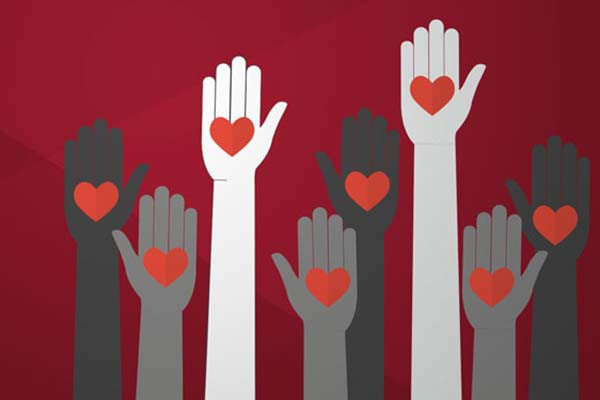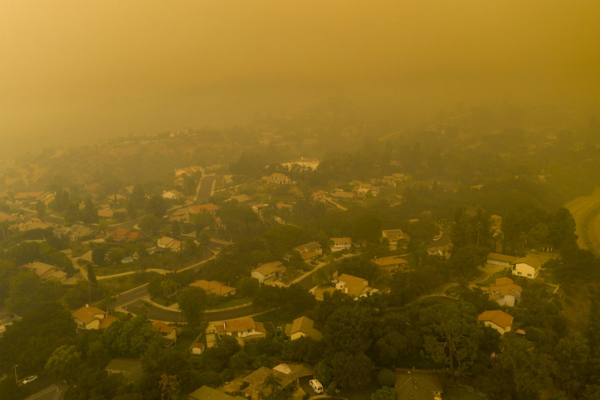
How health care leaders can prioritize health equity for the LGBTQIA2+ community

Editor's note: Health inequities have long been an issue for people in the LGBTQ+ community. We're pleased to share a post from our colleagues in Corporate Learning at Harvard Medical School focusing on solutions that health care leaders can champion.
Health care business professionals can improve patient outcomes and reduce health inequities by championing the health care needs of the lesbian, gay, bisexual, transgender, queer and/or questioning, intersex, asexual, and two-spirit (LGBTQIA2+) community. These issues are an important priority for health care professionals year-round, not just during Pride Month.
Research shows that the LGBTQIA2+ community faces disproportionate adverse health conditions due to health inequities. It’s important for those working in the health care industry to be aware of the challenges the LGBTQIA2+ community faces to help make systemic changes and improve health outcomes.
The LGBTQIA2+ community — which is less likely to trust the health care system — is a rising part of the population. The 2022 national Gallup survey shows that at least 20% of Gen Z identifies as LGBTQIA2+. This includes our coworkers, customers, and clients, says Dr. Alex Keuroghlian, a psychiatrist at Massachusetts General Hospital and faculty advisor for LGBT and Allies at Harvard Medical School (LAHMS).
“LGBTQIA2+ people experience pervasive stigma and discrimination, as well as numerous adverse social determinants of health, all of which negatively impact health outcomes,” says Dr. Keuroghlian. “Health care professionals, organizations, and governmental agencies need to intentionally provide clinical care and design health systems and policies, in a manner that is culturally responsive and improves health outcomes for LGBTQIA2+ people.”
Due to the politicized nature of these issues, health care providers around the world, including in several U.S. states, face limitations and backlash when providing gender-affirming care. In some places, Dr. Keuroghlian says, “legal restrictions on access to gender-affirming care create challenges for clinicians to deliver this care and for transgender and gender diverse people to safely receive it.”
Everyone in health care — including health care business professionals — can work to improve health outcomes and decrease inequities. “It is critical for all businesses to offer welcoming, inclusive, and affirming work environments and service delivery for LGBTQIA2+ people,” Dr. Keuroghlian says.
Supporting LGBTQIA2+ health begins in the workplace
With thoughtful action, health care business professionals can contribute to greater health equity for these underserved individuals. Some ways to do so include:
1. Take an active interest in better understanding the needs and perspectives of the LGBTQIA2+ community.
Conducting research, including surveys and consumer focus groups, is a good way to help better understand specific health needs and priorities. “This community has historically been excluded from studies and research that would be very helpful in understanding their needs and their challenges,” says Dr. Enrique Caballero, an endocrinologist at Brigham and Women’s Hospital and the faculty director of International Innovation Programs in the HMS Office for External Education. “We need to get to know the population better.”
2. Prioritize inclusive language.
Whether you are involved directly in care delivery or other aspects of health care, pay attention to the words you use — for both customers and employees. Gendered language in job postings, informational or marketing materials, and even casual conversation can be off-putting. That means lost opportunities for organizations and LGBTQIA2+ individuals. Slight shifts in language and conscious efforts like adding pronouns to your email signature speak volumes.
3. Train staff to be community allies.
Gaining awareness of our unconscious biases and making shifts in our everyday language doesn’t happen overnight. Health care industry businesses can help their staff be better allies to the LGBTQIA2+ community by providing access to workshops delivered by community members.
“No one becomes fully competent after one conversation, lecture, or video,” Dr. Caballero says. “It’s a lifelong process in which we all learn how to be more respectful, inclusive, and to embrace diversity.”
4. Support companies and community organizations that focus on LGBTQIA2+ health.
Show, don’t tell. Making financial contributions to organizations already on the ground and working with this population demonstrates that you aren’t just concerned about the bottom line. You are truly dedicated to helping the LGBTQ+ population access good health care.
5. Hire LGBTQIA2+ staff.
The best way to ensure your company is prioritizing health equity is by having a diverse group at the decision-making table. It is crucial to have employees that represent the diversity of your customer base — not only diversity in gender expression and sexuality, but also diversity in race, ethnicity, age, ability, and beyond.
“Part of our obligation is to really open the doors for everybody,” Dr. Caballero says. “Talent is not exclusive to a particular group, and I think that is important to embrace as an organization.”
6. Include LGBTQIA2+ representation in all communications.
Diverse representation is key. Make a pointed effort to include same-sex couples, non-traditional family units, and transgender and non-binary individuals in all kinds of communications, participating in everyday activities.
7. Acknowledge any missteps.
On an institutional level, company acknowledgments can go a long way in rebuilding trust with the LGBTQIA2+ community. Within the organization, it’s valuable to encourage ongoing communication about company culture.
“All organizations should have a system in place for people to provide feedback on how things are going and to report anything that they want to call the leadership team's attention to,” Dr. Caballero says. “Having a system that truly listens to members of the organization — and being sure that follow-up action is taken — is very important.”
8. Make action consistent beyond Pride Month.
Embracing the LGBTQIA2+ community consistently and with commitment all year long “is truly an opportunity for everyone,” Dr. Caballero says. “This is not good just for the members of the community, but for everybody that works in a place that embraces diversity, equity, and inclusion.”
Industry professionals turn to HMS for custom corporate learning programs, including on topics like LGBTQIA2+ health, that leave a lasting impact on participants. To provide these programs, HMS leverages faculty expertise from throughout the School and the entire Harvard University community to share with health care teams. To learn about HMS Corporate Learning custom programs, read about the approach or hear from clients themselves.
About the Author

Corporate Learning Staff
Harvard Medical School’s Corporate Learning solutions provide emerging and established companies with the knowledge they need to address the industry's toughest business challenges. Their extensive portfolio of learning solutions helps teams achieve their potential by advancing … See Full Bio View all posts by Corporate Learning Staff

One surprising effect of wildfires: Itchy, irritated skin

Are you finding yourself with itchy, irritated skin that you can’t stop scratching? Or have you wondered why your child’s eczema is suddenly worse and so hard to control? Mounting evidence suggests that wildfires, which are increasing in intensity and frequency, contribute to skin problems, including eczema flares.
What is eczema?
Eczema is a common chronic skin condition that affects about one in 10 people in the US. Its hallmarks are inflamed and dry, itchy patches of skin.
Atopic dermatitis is the most common type of eczema. It can run in families, often beginning in childhood. Typically, in the northern hemisphere, it grows worse during the winter season when the weather is cold and drying. Now some experts are seeing that pattern change. At Massachusetts General Hospital, for example, one dermatologist noted an unusual spike last summer in patients with flare-ups of eczema.
Why is eczema getting worse during summer?
In 2023, Canada experienced more than 6,000 wildfires that burned over 16 million hectares of land — an area larger than the entire state of Georgia. While far away from the devastation, the smoke reached across the US and more than 2,000 miles to Europe. Poor air quality from these distant wildfires caused eye and throat irritation and difficulty breathing.
In Boston, Dr. Arianne Shadi Kourosh, a dermatologist at Massachusetts General Hospital, also began to notice skin symptoms. Normally the dermatology clinics would see fewer than 20 people during a summer month for eczema, including atopic dermatitis. Suddenly that jumped to 160.
Looking back at summer month records from the last four years, her research showed that the number of visits for these skin complaints tracked with the severity of air pollution. These findings are consistent with other research noting an uptick in eczema flares and psoriasis flares associated with wildfire pollution. But why?
Researchers theorize that airborne pollutants might set off a cascade of effects within the body by activating an oxidative stress pathway. This damages the skin barrier and prompts an inflammatory response. This cascade also may play a role in the development of eczema.
What can you do to protect your skin?
Air pollutants in wildfire smoke may harm multiple organs — not just your heart and lungs, but also our skin, it seems. So, when outdoor air quality is bad due to wildfires, limiting your exposure can help reduce health risks. While we can say the same for industrial air pollution, wildfire pollution is likely worse due to its additional toxic particles.
- Seek help if you’re itching. Check with a dermatologist or your health team if you think wildfire smoke or other forms of air pollution might be affecting your skin.
- Check local air quality.AirNow.gov shares local, real-time air quality information and activity guidance. When recommended, stay indoors if possible. Shut doors, windows, and any outdoor air intake vents.
- Protect your skin. When you’re outdoors, wear a mineral-based sunscreen containing zinc or titanium. While most other sunscreens work through a chemical reaction to absorb the ultraviolet (UV) rays that damage skin, zinc and titanium sunscreens help by forming a barrier over skin that reflects off UV rays. The barrier also reduces the amount of pollutant particles getting to the skin to set off the inflammatory cascade. Wearing sunscreen protects against skin cancer, as well.
- Wash up. After coming back inside, cleansing your skin and applying a hypoallergenic moisturizer will help keep it healthy. If you do have eczema, choose cleansers and moisturizing products recommended by your dermatologist or health care provider.
About the Author

Wynne Armand, MD, Contributor
Dr. Wynne Armand is a physician at Massachusetts General Hospital (MGH), where she provides primary care; an assistant professor in medicine at Harvard Medical School; and associate director of the MGH Center for the Environment and … See Full Bio View all posts by Wynne Armand, MD

Shining light on night blindness

Animals renowned for their outstanding night vision include owls, cats, tarsiers (a tiny primate in Southeast Asia) — and even the dung beetle.
But humans? Not so much.
Over time, many people suffer from night blindness, also known as nyctalopia. This condition makes seeing in dim or dark settings difficult because your eyes cannot adjust to changes in brightness or detect light.
What are the dangers for those experiencing night blindness?
Night blindness is especially problematic and dangerous when driving. Your eyes cannot adjust between darkness and the headlights of oncoming vehicles, other cars may appear out of focus, and your depth perception becomes impaired, which makes it difficult to judge distances.
Night blindness also may affect your sight at home by making it hard for your vision to quickly adjust to a dark room after turning off the lights. “This can cause people to bump into furniture or trip and suffer an injury,” says Dr. Isabel Deakins, an optometrist with Harvard-affiliated Massachusetts Eye and Ear.
What happens in the eye to create night blindness?
The ability to see in low-light conditions involves two structures in the eye: the retina and the iris.
The retina, located in the back of the eye, contains two types of light-detecting cells called cones and rods. The cones handle color vision and fine details while the rods manage vision in dim light.
The iris is the colored part of your eye. It contains muscles that widen or narrow the opening of your pupil to adjust how much light can enter your eyes.
If your irises don’t properly react, the pupils can dilate and let in too much light, which causes light sensitivity and makes it hard to see in bright light. Or your pupils may remain too small and not allow in enough light, making it tough to see in low light.
What causes night blindness?
Night blindness is not a disease but a symptom of other conditions. “It’s like having a bruise on your body. Something else causes it,” says Dr. Deakins.
Several conditions can cause night blindness. For instance, medications, such as antidepressants, antihistamines, and antipsychotics, can affect pupil size and how much light enters the eye.
Eye conditions that can cause night blindness include:
- glaucoma, a disease that damages the eye’s optic nerves and blood vessels
- cataracts, cloudy areas in the lens that distort or block the passage of light through the lens
- dry eye syndrome.
However, one issue that raises the risk of night blindness that you can’t control is age. “Our eyes react more slowly to light changes as we age, and vision naturally declines over time,” says Dr. Deakins. “The number of rods in our eyes diminish, pupils get smaller, and the muscles of the irises weaken.”
What helps if you have night blindness?
If you notice any signs of night blindness, avoid driving and get checked by an eye care specialist like an optometrist or ophthalmologist. An eye exam can determine if your eyeglass prescription needs to be updated.
“Often, a prescription change is enough to reduce glare when driving at night," says Dr. Deakins. “You may even need separate glasses with a stronger eye prescription that you wear only when driving at night.”
Adding an anti-reflective coating to your lens may help to cut down on the glare of the headlights of an oncoming car. However, skip the over-the-counter polarized driving glasses sold at many drug stores. "These may help cut down on glare, but they don't address the causes of night blindness," says Dr. Deakins.
An eye exam also will identify glaucoma or cataracts, which can be treated. Glaucoma treatments include eyedrops, laser treatment, or surgery. Cataracts are corrected with surgery to replace the clouded lens with an artificial one. Your eye care specialist can also help identify dry eye and recommend treatment.
Ask your primary care clinician or a pharmacist if any medications that you take may cause night blindness. If so, it may be possible to adjust the dose or switch to another drug.
Three more ways to make night driving safer
You also can take steps to make night driving safer. For example:
- Wash the lenses of your glasses regularly. And take them to an optician to buff out minor scratches.
- Keep both sides of your front and rear car windshields clean so that you can see as clearly as possible.
- Dim your dashboard lights, which cause glare, and use the night setting on your rearview mirror.
About the Author

Matthew Solan, Executive Editor, Harvard Men's Health Watch
Matthew Solan is the executive editor of Harvard Men’s Health Watch. He previously served as executive editor for UCLA Health’s Healthy Years and as a contributor to Duke Medicine’s Health News and Weill Cornell Medical College’s … See Full Bio View all posts by Matthew Solan
About the Reviewer

Howard E. LeWine, MD, Chief Medical Editor, Harvard Health Publishing
Dr. Howard LeWine is a practicing internist at Brigham and Women’s Hospital in Boston, Chief Medical Editor at Harvard Health Publishing, and editor in chief of Harvard Men’s Health Watch. See Full Bio View all posts by Howard E. LeWine, MD